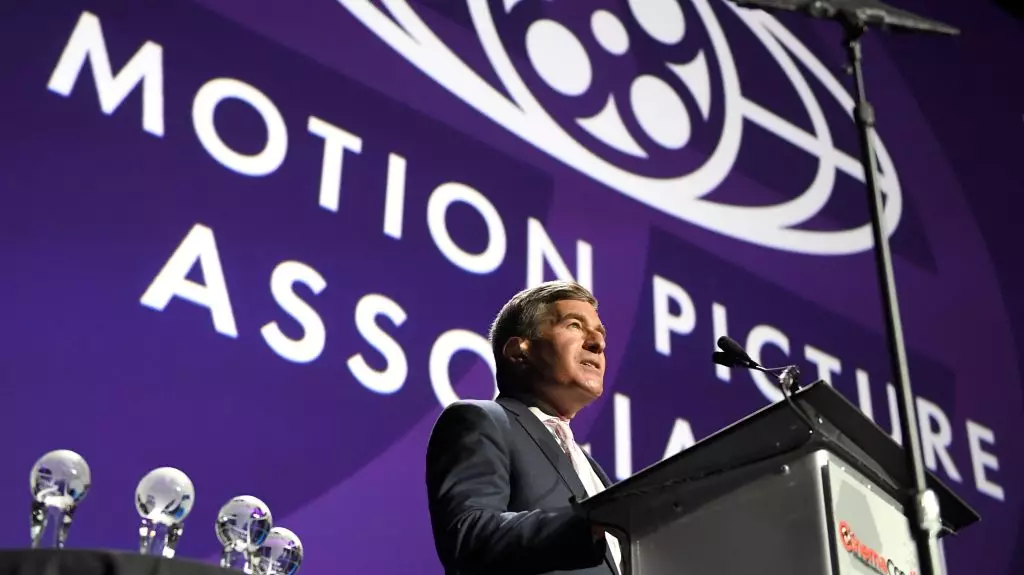At the recent CinemaCon, a momentous gathering of industry leaders, the President and CEO of the Motion Picture Association (MPA), Charlie Rivkin, conveyed an uplifting message of solidarity to theater owners amid the ever-present challenges facing the film industry. While the words echoed with hope, they also carried an urgent subtext—industry stakeholders must confront the volatility plaguing the cinematic landscape head-on. Rivkin’s acknowledgment of the unpredictability that grips both productions and exhibitions demonstrates an understanding that transcends mere rhetoric; it directly addresses the imperative of adaptability in this era of change.
The MPA not only resonates with the sentiments of theater owners who strive to bring movie lovers back to their screens but also emphasizes its commitment to guiding the industry towards a more stable future. Rivkin’s proclamation that “we want what you want” emphasizes a shared vision that could potentially bridge existing divides between production studios and theatrical releases. Yet, the path to revitalization is neither straightforward nor devoid of challenges. As Rivkin pointed out, the landscape feels more precarious than ever, but it also presents fertile ground for collaboration and innovation.
The Promise of Production
A primary focal point in Rivkin’s address was the pledge to bring an increasing number of films to theaters—specifically, a commitment from Amazon MGM Studios to release between 12 to 14 films in the coming year. This is not merely a promise; it is a clarion call for a recommitment to theatrical exhibition as the centerpiece of the film experience. The theatrical realm has endured significant turbulence, particularly exacerbated by the previous pandemic era, which saw studios pivot to streaming models. Rivkin’s call for a resurgence toward theatrical releases not only underscores the traditional cinematic experience but also highlights a broader shift in production philosophy.
Furthermore, Rivkin spotlighted the vital role of local economies benefiting from film productions. For every major film produced, the economic ramifications are profound, with thousands of jobs created and millions of dollars injected into local markets. When addressing policymakers, the MPA is not merely advocating for the film industry; it is championing economic revitalization that benefits communities at large. This acknowledgment that film and economic growth are intertwined strengthens the MPA’s mission while fostering a deeper appreciation for the film industry’s societal role.
Incentives that Inspire
One of Rivkin’s eye-opening revelations was the announcement of new tax incentives being pursued at the state level, particularly in California. Upon evaluating the staggering potential of these incentives, it becomes evident that they are integral to preserving and expanding cinematic production. The proposition of nearly $580 million in economic activity from 51 films receiving tax credits in California is a clarion example of how legislation can become a catalyst for growth. It is incumbent upon film industry stakeholders to champion these incentives and push for further legislative measures that enhance production capabilities.
The discussion surrounding tax measures is not merely academic but rather a strategic necessity for sustaining American leadership in filmmaking. As Rivkin highlighted, when the right incentives are in place, the cycle of production, job creation, and local economic revitalization becomes self-perpetuating. The MPA’s efforts to lobby for enhanced tax measures can empower studios and alleviate some of the pressures faced by theaters. These collaborative efforts will ultimately reshape the industry’s landscape, creating a symbiotic relationship between productions and theaters.
Future-Focused Action
Rivkin’s call to action aimed at fostering a united front among studios, unions, and guilds to propel the film industry toward a brighter future could not be more paramount. As the MPA seeks to extend tax initiatives that stimulate investment, the coalition it forms with various stakeholders could very well redefine the trajectory of American cinema.
In an age marked by rapid technological advancements and shifting audience preferences, standing still is not an option. The stakes are colossal; the film industry’s revival hinges on innovative practices and unyielding collaboration among players in the cinematic sphere. Rivkin’s insistence on a collective endeavor reflects a burgeoning recognition that the industry thrives best when various voices harmonize to pursue shared objectives. Together, they can usher in a new era of creativity, economic growth, and, ultimately, an enriched cinematic experience for audiences everywhere.


Leave a Reply